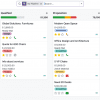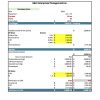Margin Calculator
Uses of Margin in Business
Margin is a critical financial metric that plays a central role in evaluating the profitability and financial health of a business. Understanding and utilizing margin effectively can provide valuable insights for decision-making, pricing strategies, and overall business management. Here are some of the key uses of margin:
1. Pricing Strategy
- Setting Prices: Margin helps businesses determine the selling price of their products or services. By knowing the cost of goods sold (COGS) and desired margin, a company can set prices that ensure profitability.
- Competitive Analysis: Understanding margin allows businesses to compare their pricing and profitability with competitors, helping them position their products more effectively in the market.
2. Profitability Analysis
- Evaluating Product Lines: By calculating the margin for different products or services, businesses can identify which are the most and least profitable. This helps in making informed decisions about which products to focus on and which might need reevaluation or discontinuation.
- Assessing Business Health: Gross and net margins provide a snapshot of the overall profitability of the business. A healthy margin indicates that a business is generating sufficient profit relative to its costs.
3. Cost Management
- Identifying Cost Reduction Opportunities: By analyzing margins, businesses can identify areas where costs may be reduced without significantly impacting quality or customer satisfaction. This could involve negotiating better terms with suppliers or finding more efficient production methods.
- Budgeting and Forecasting: Margins are essential for creating accurate budgets and forecasts. They allow businesses to predict future profits based on expected sales and costs.
4. Investment Decisions
- Assessing Potential Investments: When considering expanding product lines, entering new markets, or making other significant investments, businesses use margin analysis to predict potential profitability. High-margin opportunities are generally more attractive for investment.
- Valuing the Business: Investors often look at a company’s margins when assessing its value. Healthy margins suggest a well-managed business with strong profit potential, making it more attractive to investors and lenders.
5. Operational Efficiency
- Improving Operational Efficiency: Analyzing margins helps businesses identify inefficiencies in their operations. For example, if the margin on a product is lower than expected, it could indicate issues with production, supply chain, or pricing that need to be addressed.
- Resource Allocation: Businesses can allocate resources more effectively by focusing on high-margin products or services. This ensures that time, money, and effort are spent on the most profitable areas of the business.
6. Financial Reporting and Analysis
- Internal Reporting: Margin analysis is a key component of financial reporting, providing management with insights into the business’s financial performance. This information is crucial for making informed strategic decisions.
- External Reporting: Companies also use margin information in external financial reports to communicate their financial health to stakeholders, including investors, lenders, and analysts. Healthy margins can improve a company’s credit rating and attract investment.
7. Strategic Decision-Making
- Market Expansion: Businesses use margin analysis to determine the feasibility of entering new markets. High-margin opportunities may justify the risks associated with expansion.
- Product Development: When developing new products or services, businesses consider margin to ensure that the new offerings will contribute positively to overall profitability.
Conclusion
Margin is not just a number; it’s a powerful tool that influences almost every aspect of business management. From pricing strategy and cost management to investment decisions and financial reporting, understanding and using margin effectively can significantly impact a company’s success. By continuously monitoring and analyzing margins, businesses can make informed decisions that drive profitability and growth.









